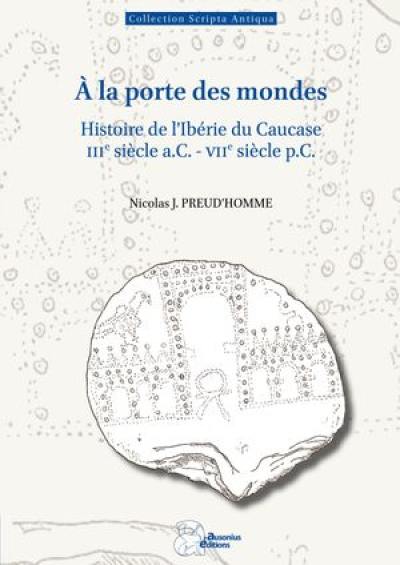
Fiche technique
Format : Broché
Nb de pages : 564 pages
Poids : 1046 g
Dimensions : 18cm X 24cm
ISBN : 978-2-35613-608-4
EAN : 9782356136084
A la porte des mondes
histoire de l'Ibérie du Caucase
IIIe siècle a.C.-VIIe siècle p.C.
Quatrième de couverture
Apparu à l'époque hellénistique, un pouvoir royal établi au débouché de la passe du Darial exerça jusqu'au VIe s.p.C. un rôle pivot dans l'histoire de l'ancienne Caucasie, à la charnière de l'empire romain, de l'Iran et des nomades des steppes du Nord. Ce pays, l'Ibérie, amalgamait divers peuples et communautés autour du cours moyen du fleuve Koura. Composant avec les rivalités dynastiques, le morcellement ethnique, la pluralité des langues et la diversité des cultures, les rois d'Ibérie firent preuve d'une remarquable capacité d'adaptation pour assurer leur emprise territoriale, affirmer leur légitimité et trouver une place de choix dans les réseaux d'alliances transnationaux. Le système politique ibère établit une relation d'équilibre entre l'aristocratie et la cour à travers une dyarchie associant le roi et son pitiaxe. Entrés dans l'orbite de Rome après l'invasion de Pompée en 65 av. J.-C., les Ibères tissèrent jusqu'à l'époque tardive un partenariat avec les dirigeants romains qui n'était cependant pas exempt d'ambivalence. Les années 260 de notre ère marquèrent un tournant capital dans l'évolution du pouvoir royal ibère, lorsque l'emprise grandissante des Sassanides instigua un changement dynastique au profit des Mihranides. Dans un contexte d'effervescence spirituelle mettant en concurrence divers courants religieux, les dirigeants ibères décidèrent progressivement de confessionnaliser leur pouvoir. Au début du Ve siècle, l'invention d'une première forme officielle d'écriture géorgienne illustra ce nouveau consensus politique et religieux autour d'une royauté devenue chrétienne, étape cruciale dans le processus d'ethnogenèse. De l'époque hellénistique à l'arrivée de l'Islam, l'ancienne société ibère, façonnée sur un modèle iranien avec une forte composante aristocratique, mit en avant certaines femmes charismatiques ayant occupé des fonctions religieuses prépondérantes dans la vie religieuse et sociale. L'adaptabilité dont firent preuve les Ibères à l'égard des circonstances fournit un exemple remarquable de l'évolution d'un pays de taille modeste à travers l'âge des grands empires de l'Antiquité. Par l'épigraphie et les chroniques géorgiennes, les Ibères nous ont aussi légué leur propre vision de l'Histoire sur ces mille ans d'existence.
An ancient kingdom established at the exit of the Darial Gorge, where the Roman Empire, Iran and the nomads of the northern steppes all met, played a pivotal role in the history of Southern Caucasia from the Hellenistic period until the 6th century CE. This country amalgamated various peoples and communities around the middle course of the Kura River. Juggling with dynastic rivalries, ethnic fragmentation, multiple languages and diverse cultures, the kings and princes of Caucasian Iberia demonstrated remarkable powers of adaptation to ensure their territorial influence, assert their legitimacy and occupy a place of choice in transnational alliance networks. The Iberian political system struck a balance between the aristocracy and the court through a diarchy which associated the king and his pitiaxes. Entering Rome's orbit after Pompey's invasion in 65 BCE, the Iberians forged a partnership with the Roman leaders until the late-ancient period which was, however, not free from ambivalence. The 260s CE marked a momentous turning point in the evolution of Iberian royal power, when the growing influence of the Sasanians instigated a dynastic change for the benefit of the Mihranids. In a context of spiritual ferment bringing various religions into competition, Iberian leaders gradually decided to reform the sacred bases of their power. At the beginning of the 5th century CE, the invention of a first official form of Georgian writing illustrated this new political and religious consensus around a kingship that had become Christian - a crucial step in the process of ethnogenesis. From the Hellenistic period to the advent of Islam, ancient Iberian society, shaped on an Iranian model with a strong aristocratic component, highlighted certain charismatic women who occupied leading functions in religious and social life. The adaptability to circumstances demonstrated by the Iberians provides a remarkable example of a country of modest size evolving through the age of the great empires of Antiquity. In their epigraphy and Georgian chronicles, the Iberians have also left us their own vision of History over these thousand years of existence.





